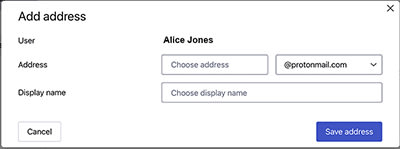Your personal email address is an essential part of your digital identity. Like your phone number, you don’t give it to everyone you meet.
That’s why it’s useful to have other email addresses you can use for different purposes. But you may not want the hassle of managing multiple email accounts, each with its own login. That’s where aliases come in.
- What is an email alias?
- Creating email aliases with subaddressing (+aliases)
- How to create an alias in Proton Mail?
- How to create an alias in Gmail, Outlook, and iCloud?
- How to organize your inbox with +aliases?
- Limitations of +aliases
- Use SimpleLogin to create unique email aliases
- Why use unique email aliases?
- What’s the difference between additional email addresses and aliases?
What is an email alias?
An alias is an additional email address that you can use with your existing email account instead of your personal email address. Much like an offline alias, an email alias is another title that you can use and be recognized by.
There are different types of email aliases:
- Email alias created with subaddressing (also called “+alias”)
- Unique email alias created with an email aliasing tool
Creating email aliases with subaddressing (+aliases)
Most of the big email providers offer email aliases, but they all behave slightly differently. Here we’ll look at Proton Mail and explain how other providers differ.
How to create an alias in Proton Mail?
In Proton Mail, you can make aliases in two ways:
- With a plus sign (+): Add “+something” to your username. For example, if your address is alicejones@proton.me, you could create aliases like alicejones+shop@proton.me or alicejones+news@proton.me. These are officially known as “email subaddresses”, though we call them “+aliases” for short.
- With new usernames: Create completely new addresses, either with a Proton Mail domain (@proton.me) or with your own custom(new window) domain (@your domain.com). For example, Alice could make aliases like ali-news@proton.me, if that address is available, or news@alicejones.com, if she owns that domain name.
With a free Proton Mail account, you can use +aliases to receive and reply to mail.
You don’t need to take any extra steps to receive mail using a Proton Mail +alias. Just think of a new address with a plus in the format above and give it out. Any mail sent to that address will arrive in your usual Proton Mail inbox.
Unlike most other email services, when you reply to mail sent to a +alias in Proton Mail, the alias automatically appears as the default From address. You don’t have to tweak any settings.
If you upgrade to a paid Proton Mail plan(new window), you can also create additional addresses with a Proton Mail domain (like @proton.me) or a custom domain (@yourname.com):
1. Sign in to your account at Proton Mail(new window).
2. In the top right, select Settings → All settings → Identity & addresses → My addresses → Add address.
3. Add a new username and choose a Proton Mail domain or custom domain from the dropdown menu.
4. Add a name in the Display name field (optional).
5. Click Save address.
After you’ve created your addresses, you can use any one of them to sign in to your Proton account. There’s no need to designate a “primary” address. And you can make any one of them your default sending address(new window).
Learn more about types of email addresses and aliases(new window) in Proton Mail and how to create and use aliases(new window).
How to create an alias in Gmail, Outlook, and iCloud?
In free Gmail accounts, you can create +aliases to receive mail, as in Proton Mail. You can also create aliases by adding periods to your username. For example, if you had the address abjones@gmail.com, you could make aliases like a.b.jones@gmail.com or ab.jones@gmail.com. However, to send emails from Gmail aliases, you’ll need to add them in Settings.
With a free Outlook account, you can make +aliases to receive email, but you can’t send or reply from +aliases. Any replies you send will show your primary email address in the From field. But you can add up to 10 new addresses (@outlook.com) as aliases in Settings to send and receive mail.
With a free iCloud account, you can receive mail at +aliases, but you can send from them only if you add them in Settings. You can also add up to three new addresses (@icloud.com) as aliases to send and receive mail.
Whichever service you use, you’ll need to upgrade to a paid plan to create aliases with your own domain (@yourdomain.com).
How to organize your inbox with +aliases
One of the most useful ways to use aliases is to sort your mail. By using filters or rules, you can automatically sort your incoming emails into folders, or apply a label or star/flag, so you can easily find them later.
For example, let’s say you’re Alice Jones with the email address alicejones@email.com. To organize your inbox, you could create aliases and filters to automatically sort your mail as follows:
- alice+shop@email.com (for online shopping and receipts): Mail is sent to a folder called “Shopping”.
- alice+news@email.com (for news updates and newsletters): Mail is sent to the “News” folder.
- alice+soccer@email.com (for updates from your soccer club): Mail is sent to the “Sport” folder and labeled “soccer”.
- ali-subs@email.com (for mail relating to subscriptions): Mail is labeled “subscriptions”.
Learn more about how to use filters(new window) with folders and labels(new window) in Proton Mail.
Limitations of +aliases
Using email aliases created with the “+” method (also called “subadddressing”) is a great way to keep your inbox organized by adding a “label” inside your email address.
But, it can’t be considered a shield against spam or data breaches, and it doesn’t hide your real email address to the sender.
Subaddressing is widely known about, so all it takes to “guess” your real email address is to remove all characters between the “+” and “@” signs.
If you want to use email aliases to better protect your online privacy, we recommend creating unique email aliases with a dedicated email aliasing tool(new window) like SimpleLogin.
Use SimpleLogin to create unique email aliases
SimpleLogin by Proton is an email aliasing tool(new window) that allows you to create unique email aliases that will instantly forward all incoming emails to the email address of your choice.
SimpleLogin aliases can provide more privacy than +aliases, and we recommend using SimpleLogin instead of +aliases. Integrate your account with Proton, so you can log into SimpleLogin with your existing Proton account and start protecting your inbox with email aliases.
We also suggest getting the SimpleLogin browser extensions or mobile apps for easier use.
Create a unique email alias from your SimpleLogin dashboard (for example, newsletter.rand0m@simplelogin.com) and use this alias anytime you need to share your email address to a third party. All emails sent to your alias will be instantly forwarded to the email address of your choice.
That way, the third party only knows your email alias, not your real email address. If you start to receive spams sent to your alias, simply deactivate the alias to keep your inbox spam-free.
Why use a unique email aliases?
Unique email aliases can help you:
- Keep your real email address hidden. By using a unique email alias for your online accounts, you can shield your primary email address from spam, including malicious email. Reserve your personal email for people you know and trust.
- Create a temporary email address. If you want to test a new product or service or need a temporary address for a short-term project, use an alias. You can delete or disable it when you’re done.
- Spot and block spam. Aliases can help you reduce spam. If a particular alias starts attracting junk mail, just delete the address and use another.
- Organize your inbox. With most email services, you can use aliases with rules or filters to automatically sort your mail into folders or apply labels.
- Add a custom domain. You can add a custom domain to SimpleLogin email aliasing tool, so you can create aliases with your own custom domain.
- Create multiple addresses for work or play: If you run a small business or club, you can use aliases for different purposes, such as job titles (director@alicejones.com) or marketing campaigns (jumbocupcakes@alicejones.com).
What’s the difference between additional email addresses and aliases?
While email aliases (+aliases or SimpleLogin aliases) can be used permanently, at least for SimpleLogin, aliases are often limited or temporary in nature.
For example, you might create an alias specifically for a particular e-commerce site that you don’t particularly trust, and disable it if you start receiving a lot of spam.
But sometimes, you might want another email address for more widespread and permanent usage. In this case, if you have a paid Proton Mail Plus or Proton Unlimited account, you can create additional Proton Mail addresses attached to your account.
For example, you might have john.smith@proton.me for your personal email, while having acmeinc@proton.me for your small business. So whether you use an address or an alias depends on your use case.
Email aliasing with Proton Mail
Between +aliases, SimpleLogin aliases, and additional addresses, Proton Mail provides many options for you to connect multiple identities to a single inbox, or to protect your email address from sites you don’t trust.
This is more options than the typical email service, and something we provide because of our strong focus on privacy and security. For a better email experience and to benefit from end-to-end email encryption, sign up for a free Proton Mail account.















